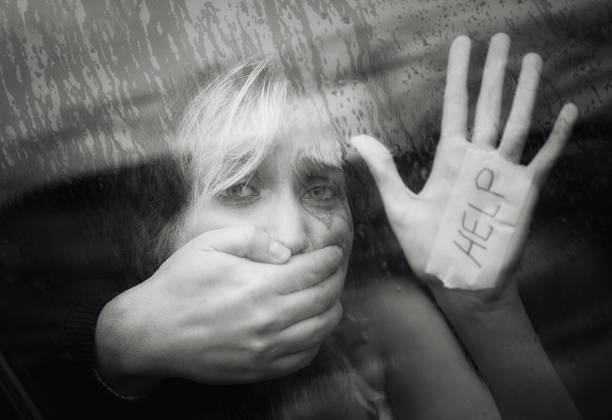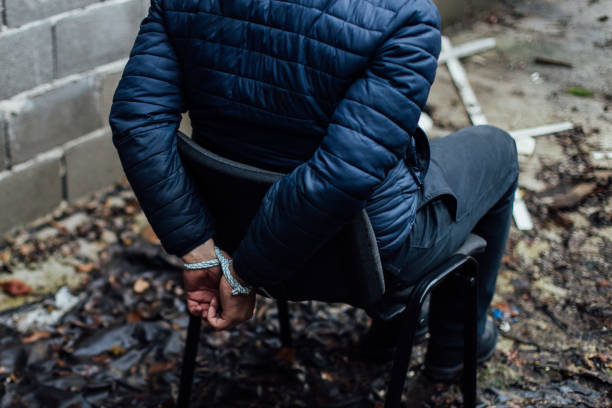
Writing Nestling


How To Describe Being kidnapped In Writing (15 Best Ways)
Describing the harrowing experience of being kidnapped in writing is an intricate and sensitive endeavor, where the power of words is harnessed to evoke fear, empathy, and raw emotional intensity.
Writers take on the profound responsibility of creating a narrative that navigates the dark corners of human suffering, examining the depths of human resilience and the complexities of trauma.
This literary exploration delves into a world where characters are thrust into a life-altering crisis, testing the boundaries of their courage and survival instincts.
It is a storytelling challenge that not only demands the utmost skill in crafting vivid descriptions but also requires a deep understanding of the psychological and ethical dimensions of such a distressing ordeal.
In this endeavor, the writer becomes a guide, leading readers through a compelling and immersive journey, offering them a glimpse into the darkness of the human soul while simultaneously illuminating the enduring strength of the human spirit.
Table of Contents
How To Describe Being kidnapped In Writing
Describing a kidnapping in writing can be a sensitive and challenging task. Here’s a step-by-step process for approaching this:
Establish Context
Start by setting the stage. Describe the location, time of day, and any relevant details about the victim and the kidnapper(s).
Introduce the Victim
Provide details about the victim, their physical appearance, emotions, and any personal history that might be relevant to the situation. This helps the reader connect with the character.
Describe the Kidnapper(s):
Similarly, introduce the kidnapper(s). Describe their appearance, demeanor, and any distinguishing features that will help the reader envision them.
Build Tension
Create an atmosphere of tension and fear. Use vivid, sensory language to convey the victim’s emotions and physical reactions. Mention their racing heart, shallow breathing, and the feeling of dread.
Capture the Moment
Describe the moment of the kidnapping. How did it happen? What actions led up to it? This could involve a struggle, sudden ambush, or a sinister approach.
Convey the Environment
Include details about the surroundings. Is it a dark alley, a remote cabin, or a moving vehicle? The setting plays a significant role in the atmosphere.
Dialogue and Actions
Incorporate dialogue and actions to move the story forward. This can include pleas for help, threats from the kidnapper, or the victim’s attempts to escape.
Emotions and Thoughts
Offer insight into the victim’s thoughts and emotions. This provides depth to the character and helps the reader empathize with their ordeal.
Use Foreshadowing
Drop hints or foreshadow events to come, adding suspense to the narrative. For example, mention the victim’s fear of the unknown future.
Conflict and Resolution
Develop the conflict and resolution of the scene. Will the victim escape or be taken to an unknown location? Describe the outcome and its immediate impact on the victim.
Maintain Sensitivity
Be cautious when describing violence and trauma. Use discretion and avoid gratuitous or graphic content that may distress readers.
Character Development
Consider how this experience will impact the character’s development and the plot of your story. Does it set up a key plot point or character arc?
Engage the Senses
Incorporate sensory details to immerse the reader in the scene. Describe sounds, smells, and physical sensations to make the scene more vivid.
Pay attention to pacing. Build tension gradually, and then, if appropriate, release it with a climax or resolution.
Edit and Revise
After drafting the scene, review and revise it for clarity and emotional impact. Ensure that it serves the broader narrative and characters.
Remember that this topic is sensitive, and your description should prioritize storytelling rather than exploiting the subject matter. It’s essential to handle such content responsibly, keeping the emotional well-being of your readers in mind.

Understanding the Context
Understanding the context is like deciphering the intricate brushstrokes of a masterful painting; each detail holds a secret, a story waiting to be unveiled.
In the realm of writing, it’s the delicate balance between the stroke of a pen and the stroke of empathy, where we navigate the treacherous waters of human experiences.
When delving into the portrayal of kidnapping, comprehending the varied forms and psychological repercussions is essential to craft a narrative that both captivates and respects the fragility of the human soul.
As writers, we become the architects of empathy, constructing worlds that invite readers to dwell within the minds of both captor and captive, urging them to see the harrowing facets of our shared humanity.
Different forms of kidnapping
Kidnapping, that harrowing act of seizing another’s freedom, comes in various chilling forms that can send shivers down one’s spine.
First, there’s the chilling ransom kidnapping, where victims become bargaining chips in a high-stakes game of financial extortion. Then, abduction, a horrifying act where individuals are snatched away from their lives and thrust into an unknown world of peril and uncertainty.
And let’s not forget the haunting specter of human trafficking, where lives are bought, sold, and bartered, leaving victims trapped in a web of exploitation.
These distinct forms of kidnapping paint a gruesome canvas of fear, each with its unique horrors, making it a subject matter that demands careful exploration in the realm of storytelling and writing.
Psychological impact on victims
The psychological impact on kidnapping victims is a haunting echo that resonates long after the physical chains have been broken.
It’s a mental landscape scarred by trauma, where trust becomes a fragile artifact, and every shadow holds the potential of danger.
Victims grapple with a spectrum of emotions, from intense fear and helplessness to anxiety, depression, and even post-traumatic stress disorder.
Their very sense of self may be shattered, as they question their worth and struggle with guilt or shame, even when they are entirely blameless.
Understanding the profound psychological wounds inflicted by kidnapping is to tread the intricate labyrinth of the human mind, where resilience, therapy, and the strength of the human spirit can eventually lead to recovery, but the scars remain etched in the deepest recesses of the soul.

Building Empathy
Building empathy is like weaving the threads of humanity into the very fabric of storytelling, creating a tapestry that allows readers to walk in the shoes of characters and understand their innermost struggles.
It’s a writer’s alchemy, where words become the elixir that dissolves the barriers of indifference and forges emotional connections.
By crafting multi-dimensional characters with rich backgrounds and motivations, we invite readers to step into the hearts and minds of both heroes and antiheroes, exploring the intricate web of human emotions.
It is in these moments of shared vulnerability that we, as writers, ignite the spark of empathy, awakening the dormant embers of compassion within our readers and immersing them in the transformative power of narrative.
Character development
Character development is the art of breathing life into the two-dimensional realm of words, forging personalities that resonate with readers long after the book is closed.
It’s akin to nurturing a seed into a thriving tree, evolving personas from mere concepts into intricate beings with their own aspirations, quirks, and imperfections.
Through their growth, characters become the storytellers themselves, each chapter a new chapter in their own inner journey.
It is in the layers of their complexities that readers find relatability, and in their evolution, we uncover profound reflections of our own humanity.
Character development is the heartbeat of storytelling, the axis upon which plots spin, and the bridge that connects fiction to the reality of human experience.
Character backgrounds and motivations
Character backgrounds and motivations are the hidden keys that unlock the mysteries of storytelling, revealing the why and how of a character’s journey.
Just like a landscape is shaped by its geology and history, characters are molded by their past experiences and inner drives. Delving into their backgrounds, we unearth the defining moments, scars, and triumphs that shape their present selves.
Their motivations, on the other hand, are the compass guiding their actions, igniting their desires, and steering the narrative forward.
Whether it’s the hero’s unquenchable thirst for justice or the antihero’s tragic pursuit of revenge, understanding the intricate web of backgrounds and motivations is the alchemical process that transforms a character from a mere puppet to a living, breathing entity, adding depth and authenticity to the story.
Setting and Atmosphere
Setting and atmosphere are the intangible sorcerers in the realm of storytelling, conjuring worlds that pulse with life and emotion.
It’s akin to painting a canvas with words, where every detail – the howling winds in a desolate moor, the ethereal glow of a bustling city at twilight, or the suffocating embrace of a dimly lit dungeon – becomes an emotional brushstroke that engulfs readers in a sensory symphony.
The setting isn’t merely a backdrop; it’s a silent character, a mood-altering elixir that can turn a simple scene into a profound experience. Atmosphere, its ethereal cousin, swirls through the narrative, tugging at heartstrings and dictating the very heartbeat of the story.
These elements are the architects of immersion, transporting readers to far-off lands or plunging them into the depths of despair, crafting a reading experience that is nothing short of enchanting.

Choosing the right setting
Choosing the right setting in storytelling is akin to selecting the perfect stage for a grand performance; it sets the tone, defines the ambiance, and becomes an active participant in the narrative.
A well-crafted setting breathes life into the story, transforming it from mere words on a page into a vivid, tangible experience.
Whether it’s the sprawling expanse of an untamed wilderness, the narrow, winding alleys of a bustling metropolis, or the eerie silence of a moonlit graveyard, the setting serves as the backdrop upon which characters move, emotions flourish, and the plot unfolds.
Its choice holds the power to immerse readers in a world they may never have known, stirring their senses and emotions.
The right setting is more than a location; it’s a silent collaborator that weaves an enchanting spell, drawing readers deeper into the narrative’s embrace.
The Kidnapper’s Perspective
The Kidnapper’s Perspective is the dark enigma that tantalizes readers’ curiosity, offering a chilling glimpse into the minds of those who exist in the shadows of morality.
It’s a narrative labyrinth where motives are as elusive as the shifting sands, and the moral compass points in unsettling directions.
As writers, we become psychological spelunkers, descending into the cavernous depths of the antagonist’s psyche, unearthing the roots of their malevolence, and deciphering their twisted rationale.
To explore the kidnapper’s perspective is to dance on the precipice of our own fears, to cast a spotlight on the depths of human darkness that can lead to acts most heinous.
This literary tightrope walk invites readers to grapple with their own moral boundaries, challenging them to peer into the abyss, all the while knowing that, in the darkest corners of a character’s mind, lies the magnetic allure of a narrative that both repels and captivates.
The psychology of the kidnapper
The psychology of the kidnapper is a perplexing labyrinth, a domain where malevolence and motivation intertwine in an intricate dance.
It is the writer’s unenviable task to venture into this shadowy realm, attempting to fathom the unfathomable. The kidnapper’s psyche may be a volatile concoction of power-seeking, desperation, or even twisted notions of justice.
Within the folds of their mind, motives and justifications are as elusive as smoke, making their actions all the more chilling.
This psychological exploration unveils not only the darkness that can reside in the human soul but also forces us to confront the uncomfortable truth that, at the root of it all, a kidnapper is still a character with their own internal logic.
Delving into their psychology, we illuminate the tangled web of their desires and the deeply flawed human nature that can lead to heinous acts, compelling readers to grapple with the unsettling question of how ordinary people can turn into monsters.
Developing a complex antagonist
Developing a complex antagonist is a masterful stroke of storytelling artistry, where the writer crafts a character who transcends the clichéd bounds of “villain.”
Instead, this antagonist becomes an enigmatic force, a mosaic of human traits that defy the conventional black-and-white morality.
They may possess a compelling blend of charisma and cruelty, embodying virtues and vices that intertwine in an intricate dance.
These characters are driven by motives as convoluted as the human psyche itself, with fears, desires, and insecurities that resonate with readers.
In this complexity, we create a narrative that transcends simplicity, and in the heart of this adversary, we uncover the emotional and moral shades of gray.
Developing such an antagonist challenges us to explore the depths of human nature, blurring the line between hero and villain, inviting readers to ponder the intricate interplay of darkness and light that resides within us all.
The Victim’s Experience
The Victim’s Experience is a haunting symphony of human resilience, where the profound echoes of trauma reverberate through the corridors of the soul.
It’s a narrative pulse that throbs with fear, courage, and the indomitable spirit of those who defy despair. As writers, we become the scribes of survival, delving into the darkest crevices of the human experience, where vulnerability meets strength.
To explore the victim’s experience is to walk the precarious tightrope between pain and empowerment, capturing the raw emotions, shattered trust, and the long, arduous journey towards healing.
In these characters, we reveal the heart-wrenching, yet inspiring, aspects of the human spirit, a testament to the resilience that can emerge from the crucible of suffering, inviting readers to not only empathize but to witness the extraordinary transformation that arises from the depths of adversity.

First-person narrative vs. third-person narrative
The choice between a first-person and a third-person narrative is akin to selecting the lens through which readers perceive a story. In the realm of the first-person narrative, we invite readers to don the shoes of the protagonist, seeing, feeling, and experiencing the world through their eyes.
It’s an intimate journey, granting direct access to the innermost thoughts and emotions of the central character, creating an immersive and empathetic connection.
On the other hand, the third-person narrative allows for a broader, panoramic view, where the writer becomes an omniscient observer, able to explore multiple perspectives and intricacies of the plot.
Each narrative style wields its own unique strengths and limitations. First-person offers immediacy and emotional depth, while third-person provides a wider canvas for a complex, multifaceted narrative.
The choice between them shapes the story’s voice and intimacy, fundamentally affecting how readers engage with and interpret the tale.

The emotional and physical trauma
The emotional and physical trauma, intertwined like thorns in the narrative’s flesh, evoke a vivid spectrum of human suffering.
The emotional trauma, often the silent, invisible scar, gnaws at the psyche of characters, leaving behind a shadowy imprint of fear, grief, and shattered trust.
It’s a complex journey through the labyrinth of post-traumatic stress, anxiety, and a profound sense of vulnerability.
Physical trauma, on the other hand, manifests as a visceral, tangible agony – the wounds, the pain, and the scars that bear witness to the character’s ordeal. Together, these twin specters haunt the pages, leaving readers both heartbroken and awestruck by the resilience of the human spirit.
They are the crucible through which characters are forged, where the darkest moments become the catalyst for transformation, making the exploration of trauma in writing a profound and deeply affecting journey for both writer and reader alike.
The internal struggle and resilience
The internal struggle and resilience form a dynamic duo within the crucible of storytelling, the yin and yang of character development.
It’s a delicate balance between the tormenting weight of adversity and the indomitable strength of the human spirit. The internal struggle, an emotional tempest raging within the character’s soul, lays bare the vulnerabilities, doubts, and fears that accompany their ordeal.
It’s the very essence of their humanity, their fight to overcome despair, making them relatable and real. Resilience, on the other hand, is the phoenix that emerges from the ashes of suffering, the unwavering determination to rise above, and the profound capacity to heal.
Together, these facets create a narrative arc that is a testament to the unbreakable spirit of the human condition, where the darkest nights give birth to the brightest dawns.
Writing about this internal struggle and resilience allows readers to witness the extraordinary metamorphosis of characters , inspiring hope, courage, and the unwavering belief that even in the face of adversity, the human spirit can triumph.
Dialogue and Communication
Dialogue and communication are the lifeblood of storytelling, the intricate dance of words that weaves the very essence of characters and plot.
Like the elusive threads of a spider’s web, they bind readers to the hearts and minds of characters, making emotions tangible and thoughts audible.
Dialogue is more than just words; it’s the symphony of voices, the clash of ideas, and the hidden truths and deceptions that surge beneath the surface.
Communication, in its myriad forms, from body language to silence, is the unsung storyteller, revealing the unspoken emotions and tensions that linger in the spaces between words.
As writers, we are the conductors of this orchestra, setting the tempo, infusing nuance, and revealing the intricate connections between characters.
Dialogue and communication are the conduits of understanding, conflict, and revelation, making them the mesmerizing tools that beckon readers to immerse themselves in the multifaceted world of a narrative.
Kidnapper-victim interactions
Kidnapper-victim interactions are a high-stakes, emotionally charged tango within the narrative, where power dynamics, fear, and humanity collide.
It’s a complex, psychological chess match that unfolds in the confined spaces of captivity, where characters are thrust into an uncomfortable intimacy.
Kidnappers employ manipulation, coercion, and threats to maintain control, while victims navigate a harrowing terrain, seeking moments of vulnerability to outmaneuver their captors.
These interactions are the crucible where the true depths of character are unveiled, where empathy and defiance, resilience and desperation, play out in a gripping, life-and-death struggle.
Writing these interactions is a tightrope walk, where the dance between predator and prey can shift in an instant, capturing the essence of human survival and the unpredictability of the human psyche, making it a riveting and emotionally charged facet of storytelling.
Non-verbal cues and communication
Non-verbal cues and communication are the unsung heroes of storytelling, the silent whispers that convey emotions and intentions without uttering a single word.
These subtle cues, from a trembling hand to a fleeting glance, carry a world of meaning, often revealing more about a character’s state of mind than any dialogue could.
They provide readers with a deeper understanding of the unspoken truths, hidden fears, and concealed desires that reside within characters.
As writers, it’s in the careful observation and artful description of these non-verbal cues where we can masterfully craft tension, suspense, and the rich subtleties of human relationships.
It’s the interplay between what is said and what is left unsaid that adds layers of complexity to the narrative, inviting readers to delve beneath the surface and explore the depths of the human condition in all its intricate glory.
Escalation and Conflict
Escalation and conflict in storytelling are like fireworks in the night sky, igniting the narrative with vivid bursts of tension and excitement.
They are the art of suspense, the beating heart of a plot, and the tantalizing crescendo that keeps readers on the edge of their seats.
Escalation is the slow, deliberate tightening of the narrative screws, raising the stakes and deepening the characters’ struggles.
Conflict is the spark that sets the stage ablaze, pitting characters against each other or the formidable forces that oppose them.
In this thrilling dance, every twist and turn, every clash of wills, and every twist of fate propels the story forward, creating a magnetic narrative that keeps readers feverishly turning pages, eager to uncover the fates of the characters they’ve grown to love.
It’s the magnetic pulse that pulls readers into the narrative, inviting them to embark on an exhilarating rollercoaster ride of emotions, where triumph and tragedy are but a heartbeat away.
Tension-building techniques
Tension-building techniques in storytelling are the master strokes of a literary craftsman, the artful creation of anticipation, unease, and emotional intensity that draws readers deeper into the narrative.
It’s like pulling the string of a bow, gradually tightening it until it’s ready to release with a thrilling force. Writers employ a diverse array of tools: foreshadowing, enigmatic clues, withholding critical information, and the meticulous pacing of revelations.
It’s the drip-drip of suspense, the mounting apprehension, and the lingering sense that something significant is about to happen that keeps readers riveted.
Tension-building techniques are the invisible hand that holds readers captive, urging them to turn one more page, to uncover one more secret, making the journey through the story a relentless and irresistible tug-of-war between curiosity and dread.

Plot twists and turning points
Plot twists and turning points are the heart-pounding surprises that send ripples through the narrative, injecting a shot of adrenaline into the storytelling’s veins.
They’re like hidden trapdoors in the plot, expertly concealed until the precise moment they’re sprung, leaving readers gasping in astonishment.
Plot twists and turning points are the art of narrative manipulation, where the expected is deftly subverted, and the unforeseen takes center stage.
As writers, we orchestrate these moments with precision, creating a rollercoaster of emotions, jolting readers from complacency and guiding them through a labyrinth of revelations, where mysteries unravel and hidden truths come to light.
They are the narrative’s fireworks, the crescendos in a symphony, leaving readers exhilarated and yearning for more, making these storytelling tools a thrilling and indispensable facet of storytelling.
Psychological and physical conflicts
Psychological and physical conflicts are the two compelling forces that shape the very core of storytelling, rendering characters as dynamic as they are relatable.
The psychological conflict brews within the depths of a character’s mind, birthing a turmoil of emotions, doubts, and choices.
It’s the moral quandary, the internal battles, and the ceaseless struggle for identity. In contrast, physical conflict is the external clash of actions, whether it’s a life-or-death duel, an epic battle, or a thrilling chase.
These two facets are the yin and yang of narrative, intertwining in a mesmerizing dance, where characters must grapple not only with their external adversaries but also with their internal demons.
It’s through the synthesis of psychological and physical conflicts that the narrative becomes a living, breathing entity, mirroring the complexity of human experience, and inviting readers to immerse themselves in a tumultuous journey of triumph and despair.
Moral and Ethical Considerations
Moral and ethical considerations in storytelling are the North Stars that guide the writer’s compass through the treacherous waters of human experience.
They are the threads that weave the delicate fabric of empathy and understanding, demanding writers to navigate the darkest corners of the human soul with sensitivity and care.
In the alchemical process of storytelling, these considerations are the cauldron where values, cultural norms, and profound questions about right and wrong simmer.
They compel us to balance the portrayal of moral ambiguity with the responsibility of offering insight and introspection.
As writers, we are not mere observers but torchbearers of the moral and ethical dilemmas our characters face, inviting readers to ponder the complexities of human nature and the choices that define us.
Navigating this intricate terrain is the soul-searching journey of every storyteller, illuminating the transformative potential of narratives that resonate on a moral and ethical level, capturing the essence of what it means to be human.
Post-Kidnapping Recovery
Post-kidnapping recovery is the poignant symphony of resilience, a narrative chapter where shattered souls reassemble themselves like fractured mosaics.
It’s the dawn after the darkest night, where characters must navigate the arduous path from victimhood to survivorship, piecing together the fragments of their shattered lives.
The scars, both seen and unseen, become a testament to their indomitable spirit, where each step forward is a victory against the haunting specter of trauma.
In these moments of rebuilding, the narrative finds its hope and redemption, and readers are invited to witness the extraordinary capacity of the human spirit to heal, thrive, and ultimately triumph.
Post-kidnapping recovery is the powerful reminder that even in the wake of unimaginable adversity, the human heart can endure, and the human will can rise, painting a vivid tapestry of courage, redemption, and the inexorable drive to reclaim life’s stolen moments.
Frequently Asked Questions (FAQ) about How To Describe Being kidnapped In Writing
Why would someone want to describe a kidnapping in their writing.
Describing a kidnapping in writing can serve various narrative purposes, such as building tension, character development, and advancing the plot. It’s a dramatic element that can add depth to a story.
How can I make a kidnapping scene in my writing more unique and compelling?
To make your kidnapping scene stand out, focus on character reactions, the psychology of the victim and kidnapper, and the emotional impact of the event. Explore unique settings, motives, and consequences to add depth to your narrative.
What are some common mistakes to avoid when describing a kidnapping in writing?
Avoid gratuitous violence and graphic details for shock value. Instead, prioritize the emotional and psychological aspects. Also, be sensitive to the potential triggers for readers and handle the subject matter with care.
Can I use a kidnapping scene as a plot device in my story?
Yes, a kidnapping can be a powerful plot device, but be sure to integrate it seamlessly into your story’s larger narrative. Consider the long-term consequences for characters and the overall plot development.
How do I maintain a balance between describing a kidnapping realistically and not being overly disturbing to my readers?
Focus on the psychological and emotional aspects of the characters involved rather than explicit violence. Use your words to evoke fear, tension, and suspense without resorting to gratuitous violence or gore.
Are there any legal or ethical concerns when describing a kidnapping in writing?
While there are no legal restrictions on describing a kidnapping in fiction, ethical considerations are important. Be mindful of your responsibility as a writer to portray sensitive subjects with care and respect.
How can I ensure that my readers don’t misinterpret my writing or become distressed by a kidnapping scene?
Provide appropriate content warnings or trigger warnings at the beginning of your work if you believe that the content may be distressing to some readers. This allows them to make an informed choice about reading your story.
Are there any recommended resources for researching how to describe a kidnapping realistically and sensitively?
Research is crucial. Consult real-life accounts, psychology resources, or speak with experts to better understand the emotional and psychological aspects of kidnapping. Always approach this research with sensitivity.
Can I use metaphor or symbolism to convey the experience of being kidnapped in a more abstract way?
Absolutely. Metaphor and symbolism can be powerful tools for conveying complex emotions and experiences. It allows you to explore the themes and consequences of kidnapping in a more abstract and artistic manner.
How do I handle feedback or criticism from readers who find my kidnapping scene distressing or offensive?
Listen to feedback with an open mind and be prepared to revise your work if necessary. Understand that readers may have different sensitivities, and it’s essential to respect their perspectives while also expressing your artistic intentions.
In the art of describing being kidnapped in writing , the storyteller wields the power to touch the very heart of human experience.
It is a craft that demands finesse, empathy, and a keen understanding of the psychological and emotional landscapes that define such harrowing experiences.
In crafting this narrative, writers embrace a responsibility to tell these stories with sensitivity and respect, offering readers not just a window into the abyss of despair but also a beacon of hope and resilience.
By exploring the multifaceted aspects of kidnapping, we deepen our comprehension of the human condition, the shades of light and darkness that coexist within us all.
Ultimately, it is in the delicate balance between the portrayal of suffering and the triumph of the human spirit that we discover the compelling and transformative potential of storytelling, transcending mere words to leave a lasting imprint on the hearts and minds of readers.
Related Posts:
- How To Write Masochistic Characters (10 Important Tips)
- How to Describe a Heart Attack in a Story (10 Best Tips)
- How To Describe A Homeless Person In writing (16…
- How To Write Bullying Scenes (12 Important Steps)
- How To Describe Fear In Writing (13 Steps You Need To Know)
- How To Describe A Depression In Writing (14 Steps…
Similar Posts

How To Describe Stars In Writing (10 Important Tips)
In the boundless expanse of the literary cosmos, the art of describing stars transcends mere prose; it becomes a celestial ballet where words waltz with the brilliance of distant suns. To capture the essence of stars in writing is to embark on a journey through the nocturnal tapestry, where each word is a luminescent stroke…

How To Improve Creative Writing (18 Effective Ways)
Embarking on the journey to improve one’s creative writing is like setting sail into an uncharted sea of boundless imagination and linguistic exploration. Creative writing, a realm where words transform into vivid narratives, characters come to life, and emotions are painted across the pages, is a skill that thrives on constant growth and evolution. In…

How To Describe Teacher In Writing (10 Important Steps)
In the intricate tapestry of education, the task of describing a teacher in writing emerges as a unique and compelling endeavor. Beyond the confines of a classroom, the narrative unfolds as a literary journey, exploring the nuances, influences, and intrinsic qualities that define an educator. This venture transcends the ordinary and delves into the art…

How To Write A Manifestation For Love (12 Best Ways)
The pursuit of love, with all its complexity and beauty, has captivated the hearts and minds of humans throughout history. While the path to finding and nurturing love often appears mysterious and elusive, many believe in the incredible power of manifestation to invite love into their lives. “How to Write Manifestation for Love” is a…

How to Describe Confusion in a Story (10 Best Tips)
In the intricate tapestry of storytelling, emotions serve as the vibrant threads that weave together the fabric of narrative. Among these, confusion stands as a particularly compelling and complex motif, offering authors a rich palette with which to evoke intrigue, tension, and empathy within their readers. Describing confusion in a story is akin to capturing…

How To Write A Book For Baby (15 Best Ways)
Embarking on the enchanting journey of creating a book for babies is a venture into a world where simplicity is a symphony, and every word is a step in the dance of early literacy. Crafting a literary treasure for the tiniest readers is an art that transcends mere storytelling; it’s a celebration of the delicate…

IMAGES
VIDEO
COMMENTS
Kidnapped Story Essay Sample. The time when I almost got kidnapped on an icy cold Thursday, December 17 the day before winter break, I faced the biggest fear of my life being kidnapped. It all started after school I had stayed after school to make up my grade for science class because I had a b in it and I wasn’t satisfied enough with that ...
How To Describe Being kidnapped In Writing. Establish Context. Introduce the Victim. Describe the Kidnapper (s): Build Tension. Capture the Moment. Convey the Environment. Dialogue and Actions. Emotions and Thoughts.